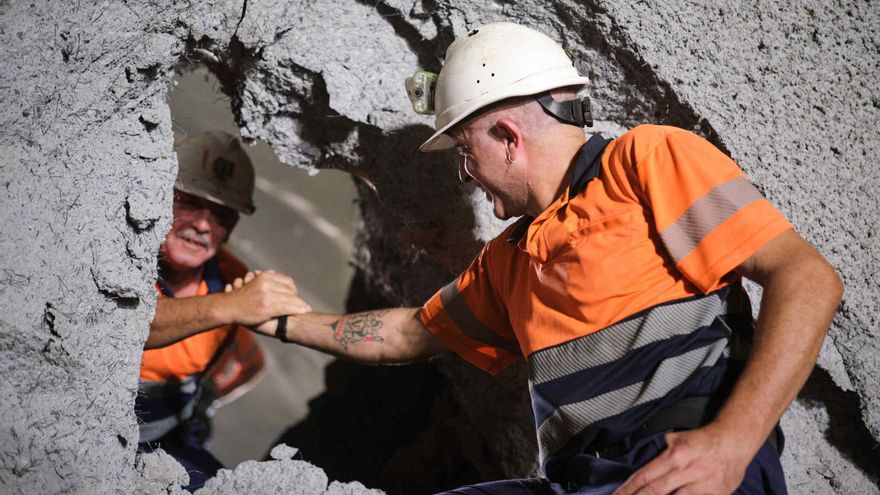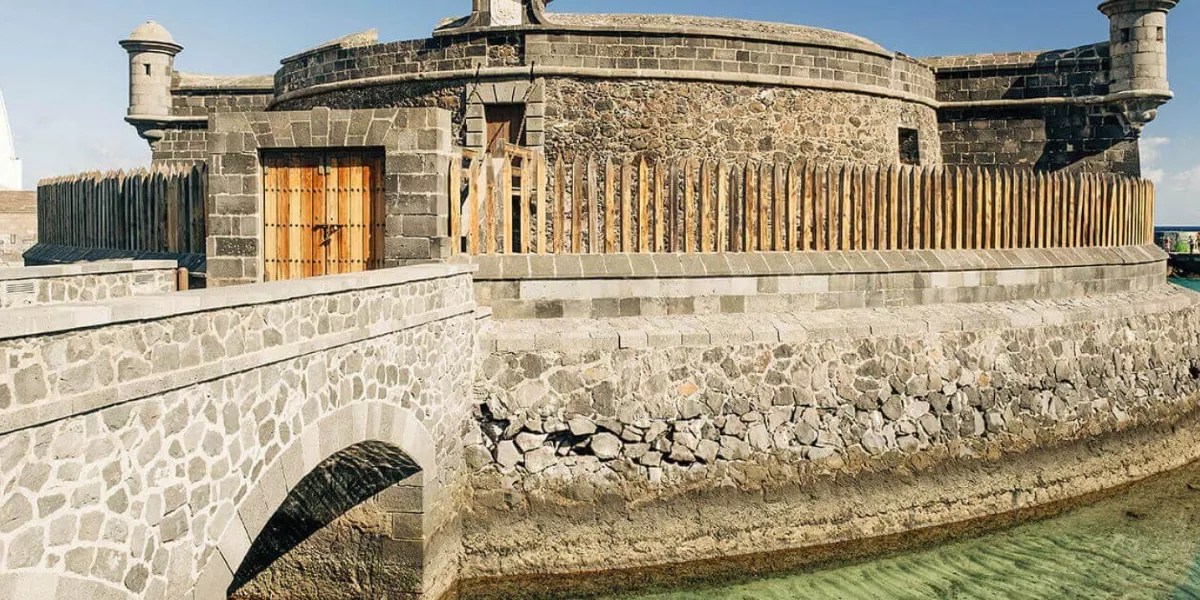
After 992 days since on October 7, 2020, a team made up of 70 workers began to excavate the two entrances of the Erjos tunnel, completion of the drilling of the first of the tunnels. At 8:03 p.m., the heavy machinery drilled from the north side the last four meters of wall that separated the three-kilometer gallery drilled from the south. With this, 4,885 meters of excavated length were reached.
The second tunnel already has 4,555 meters excavated, that is, 97% of its layout. The Canarian Government hopes that the drilling of the remaining 300 meters to complete its depth will be completed in August. In both mouths we must add two false tunnels of 140 meters to the South and 100 meters to the Northuntil reaching the 5.1 kilometers foreseen in the project.
The meeting between both ends of the Erjos tunnel was attended by the acting president of the Canary Islands, Ángel Víctor Torres; his counterpart from the Cabildo de Tenerife, Pedro Martín; the mayor of Santiago del Teide, Emilio Navarro; the mayors of El Tanque, Los Silos and Buenavista, Esther Morales, Carmen Luz aso and Eva García, respectively; the regional councilor and deputy councilor for Ecological Transition, José Antonio Valbuena and Miguel Ángel Pérez, respectively, in addition to José Luis Delgado, general director of Road Infrastructure of the Government of the Canary Islands.
The second tunnel already reaches 4,555 meters excavated, that is, 97% of its route
With a budget of more than 256 million euros, after the price review, and half a year more than the execution period, until March 2025, these works are financed by the Highway Agreement. After 42 months of work, the Ministry of Public Works paid work certifications for a value of 120,334,038 euros, which correspond to 47% of the initial budget. Of the total cost, 18 million euros are dedicated to environmental actions in the area around the work.
The joint venture formed by FCC Construcción, Syocsa-Inarsa and El Silbo employs 102 workers directly between operators and specialized personnel in three eight-hour shifts, seven days a week. The work indirectly employs another 204 employees, including suppliers, drivers or restaurant staff who serve the workers.
An example
The president of the acting regional Executive, Ángel Víctor Torres, stressed that this work is the result of “a job well done in these four years, in which, of the 16 projects of the road agreement for Tenerife, a total of 13 ( 80%) are already in the bidding phase, under construction and with environmental impact statements.” Torres hopes that the new Canarian government will maintain this action as a priority.
“”With the opening of the tunnel, we achieved undoubted progress. In approximately one year the work will be completed and this work, probably one of the most necessary for the Island, will become a reality,” remarked the president of the Tenertife Council, Pedro Martín, for whom yesterday a milestone was recorded for Tenerife.
Emilio Navarro, mayor of Santiago del Teide, stated that the Erjos tunnel is “the most important infrastructure that is executed in Spain” because it will mark a before and after in the region, both economically and socially and in health. Its commissioning will promote family reconciliation.
The work
The project consists of the construction of the closing section of the Tenerife Island Ring that will connect the Autopista del Norte (TF-5), in the municipality of El Tanque, with the Autopista del Sur (TF-1) in Santiago del Teide, giving continuation of the road activities between Adeje and Santiago del Teide, in the South, as well as between Icod de Los Vinos and El Tanque, in the West.
This new section of the road network will be 11.3 kilometers long and will link the north and south corridors of the Island with a safer road with greater capacity than the current TF-82. In addition, it will save drivers more than 45 minutes compared to the road in use. In this way, the TF-1 and TF-5 will be connected to the West.
The most important performance of the work is the construction of the Erjos Tunnel. This underground work, made up of two parallel tubes each 5.1 kilometers long, runs under the Teno Massif and is the longest tunnel in the Archipelago, as well as one of the longest road tunnels in Spain.
Route
The route starts from El Tanque, at an altitude of 600 meters, right in the area where the previous subsection between Buen Paso and El Tanque ends. From here, the layout crosses this town to the south until it intercepts the TF-82 main road at the height of the Barrio Nuevo, crossed by an artificial tunnel, from where, as it ascends, it begins to turn south to pass between Lomo Morín ( Los Silos) and the area of Nogueros (El Tanque), where the northern mouth of the Erjos tunnel is located, approximately one kilometer west of the town of Ruigómez (El Tanque) and at an elevation of 775 metres.
The southern mouthpiece is located in Santiago del Teide, where the new road will run along the southern edge of the urban area until it connects with the southern section of the Insular Ring, which ends in the Las Manchas area.
One of the aspects in the process of being corrected with respect to the original project is to provide it with a second lane in each direction, since the one that is being executed contemplates a simple roadway 3.50 meters wide in the open sky. The process to tender the modification is already underway.
As for the structures included in this project, nine are built: a viaduct, an artificial tunnel to save the population center of Barrio Nuevo (El Tanque), four underpasses and two overpasses to save the road junctions with various roads or roundabouts, as well as a pedestrian walkway that will serve to maintain the Camino de la Virgen de Lourdes (included in the Almond Blossom Route) from Santiago del Teide. There are 28 drainage works and 11 walls, as well as two links, one in El Tanque and another in Santiago del Teide.
The forecast is that this road will register 17,000 vehicles a day from 2025 and reach 30,000 in a decade
With two lanes in each direction, the Public Works forecast is that in the year of commissioning (2025) the section of highway between Santiago del Teide and El tanque registers a daily traffic of 17,000 vehicles, much higher than the 5,000 initially raised . In more than a decade, the projection is that it will reach 30,000 vehicles a day. The time saved by users who will travel from North to South on this road will be 20 minutes with fluid traffic, according to the regional Executive.
The closure of the Island Ring to the West of Tenerife has been planned as a necessary measure to balance North-South vehicle traffic, facilitating access for people residing in the North to the jobs offered by the southern region of the Island, avoiding residence displacements that are common today and guaranteeing equality for all citizens to access their jobs. For this reason, it is vitally important to facilitate this mobility in better safety, comfort and time-saving conditions than those offered by the current TF-82.















